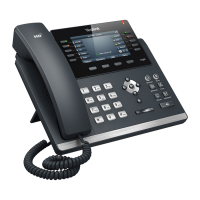Administrator’s Guide for SIP-T46G IP Phone
156
Power Management -- provides information related to how the IP phones are
powered, power priority, and how much power IP phones need.
Inventory Management -- provides a means to effectively manage the IP phones
and the attributes of the IP phones such as model number, serial number and
software revision.
TLVs supported by the IP phones are summarized in the following table:
The network address of the IP phone.
The MAC address of the IP phone.
Seconds until data unit expires.
The default value is 60s.
Name assigned to the IP phone.
The default value is ―yealink‖.
Description of the IP phone.
The default value is ―yealink‖.
The supported and enabled capabilities
of phone.
The supported capabilities are Bridge,
Telephone and Router.
The enabled capabilities are Bridge and
Telephone by default.
Description of port that sent data unit.
The default value is ―WAN PORT‖.
IEEE Std 802.3
Organizationally
Specific TLV
MAC/PHY
Configuration/Status
Duplex and bit rate settings of the IP
phone.
The Auto Negotiation is supported and
enabled by default.
The advertised capabilities of PMD.
Auto-Negotiation is: 100BASE-TX (full
duplex mode), 100BASE-TX (half duplex
mode), 10BASE-T (full duplex mode),
10BASE-T (half duplex mode).
TIA
Organizationally
Specific TLVs
The MED device type of the IP phone and
the supported LLDP-MED TLV type can be
encapsulated in LLDPDU.

